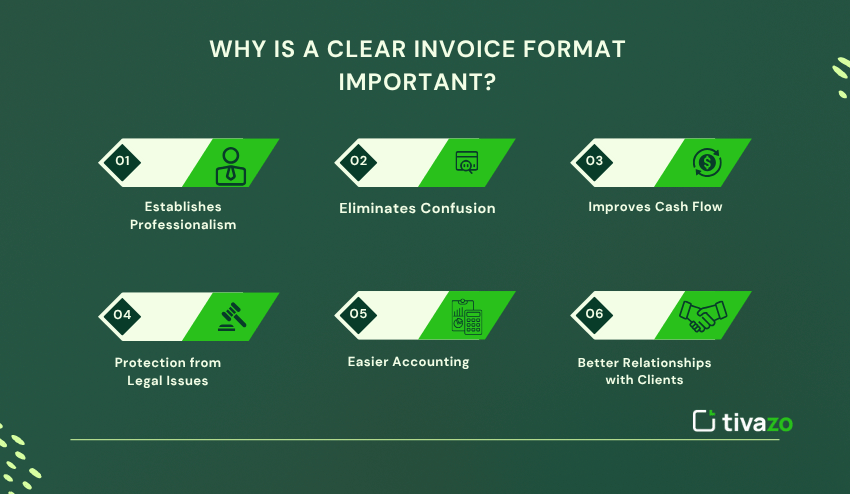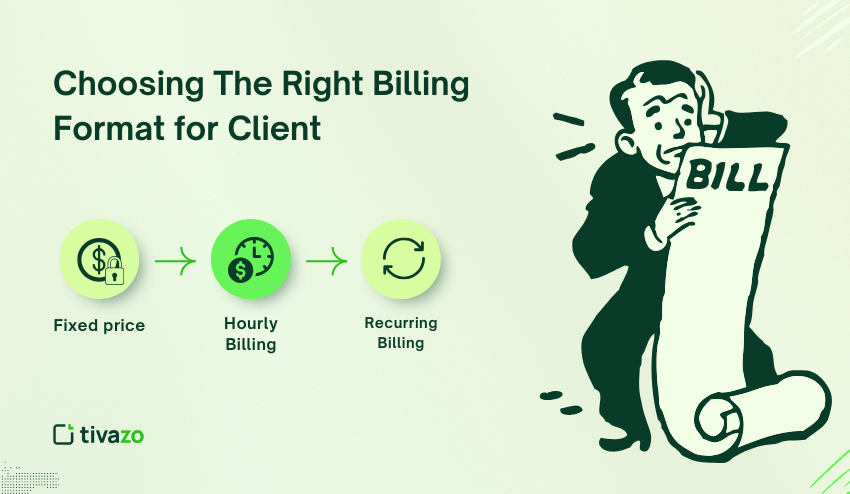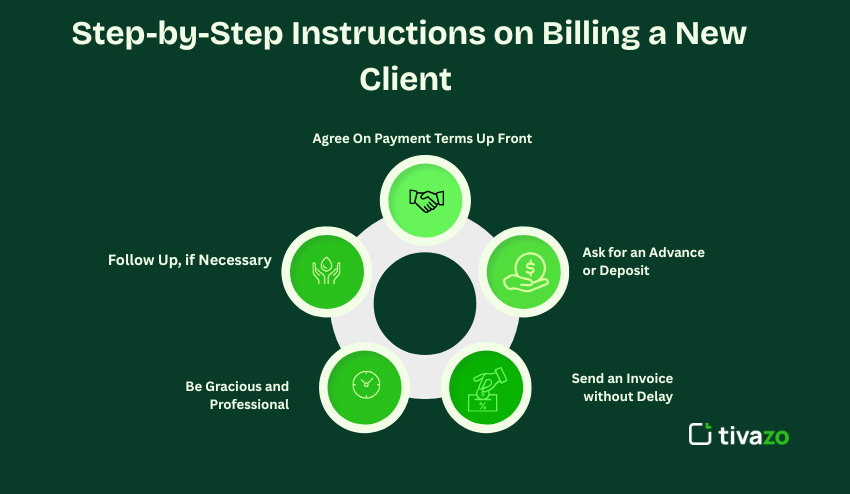Getting paid correctly is a surefire way to ensure your business runs smoothly, projects a healthy cash flow, and provides the foundation for more reliably generating work from clients over the long term. For independent contractors, freelancers, and small business owners, whether you are doing a project alone or as part of an entire team, getting all aspects of the simple billing format for the client correct is a way to make a greater impression while ensuring prompt payment.
This blog post outlines everything you need to know about billing your clients, including where to start, types of billing, step-by-step directions for creating bills, and best practices to help convince clients that they should pay your bills faster.
Key Highlights:
- Understanding client invoices: Billing format is important
- Three Types of Billing
- Creating Customer Invoices: Step-by-Step Guidelines
- How Should Freelancers Bill Clients?
- How to Bill a Client You Just Met?
- Convincing Your Clients to Pay You?
- How to Bill a Client in Word?
- How Do You Bill a Client for Shopping?
- Example of a simple Billing Format for Client
- Hints for Creating a Billing Format
Understanding client invoices: Billing format is important
Client invoices are more than just documents; they represent your brand, clarify your terms of payment, and help eliminate confusion. When using invoice formats, the client must understand what services/products they are paying for, how much, and when.
A clear invoice reduces confusion, leading to fewer disputes, provides quicker payments, and establishes trust. If you want your clients to pay on time and be happy, this is your starting point.
Why is a clear invoice format important?
- Establishes Professionalism – Using a consistent format indicates that your business is responsible and organized, and makes a strong impression on clients.
- Eliminates Confusion – Itemized services/products make it clear to your clients what they are being charged for and minimize the risk of disputes.
- Improves Cash Flow – Having a precise invoice with specified payment terms will help companies pay invoices quickly.
- Protection from Legal Issues – A well-constructed invoice acts as a legal document if there are any disputes over payment or in the event of an internal audit.
- Easier Accounting – All parties are using the same invoice (or close) format, allowing for easier tracking and more accurate bookkeeping and tax preparation.
- Better Relationships with Clients – When your billing is clear and straightforward, it adds transparency and builds trust, making it easier to retain a client and earn referrals.
In summary, investing your time into creating a clear billing format for client each month will allow you to save time later, relieve stress, and also deepen your relationship with your clients.

Three Types of Billing
It is important to understand so you can choose the best method for billing format for client that suits your business model and your clients’ expectations. Here are three of the most common billing methods used in any industry:
| Billing Method | Description | Best For |
| Fixed Price Billing | The client pays an agreed-upon (fixed) price regardless of how much time is spent (A fixed price allows clients to have an upfront sense of costs | Projects that are based on work, product sales, or one-time services where the scope of work and deliverables are relatively defined. |
| Hourly Billing | The client pays for the actual hours worked. This is often estimated or tracked using spreadsheets or time-tracking tools. | Freelancers or consultants, agencies, or any projects that have an uncertain amount of time spent. |
| Recurring Billing | The client pays a fee on a regular cycle (weekly, monthly, annually, or other) for ongoing service or subscriptions. | Subscription-based services, retainers, memberships, or continuous service contracts. |
Choosing The Right and Simple Billing Format for Client
- Fixed price: projects help clients budget with costs and scopes, but are more prone to disputes further along because of the lack of a written agreement of deliverables and defined project scopes.
- Hourly Billing: provides flexibility and transparency but depends on accurate timekeeping.
- Recurring Billing: creates predictability in income and develops longer-term relationships with clients.
Choosing the best billing method that caters to your business, the needs of your clients, and allows for smooth cash flow and happy clients is important.

Creating Customer Invoices: Step-by-Step Guidelines
The correct procedure for simple billing format for client & creating invoices should not take much time if you simply follow these step-by-step guidelines:
Step 1: Prepare Your Format
- You can use Microsoft Word, Microsoft Excel, or professional invoice and accounting software.
- Be sure to choose a blank or clean and professional template for your invoice.
Step 2: Add Your Business Information
- You should enter your company name, address, email, and telephone number.
- As well as your client’s name and contact information.
Step 3: Assign a Billing Number and Date
- Provide a unique invoice number for internal tracking.
- Invoice date and payment due date.
Step 4: Enter Services or Goods
- List description, quantity, unit price, and total.
- Include any taxes if applicable.
Step 5: Calculate Totals
- Subtotal and all taxes, etc., discounts, and total.
Step 6: Offer Payment Terms and Methods
- The methods of payment that will be accepted.
- The due date of payment and any late payment terms.
Step 7: Check and Send
- Double-check all entries.
- Email invoice or send them via professional billing software.
How Should Freelancers Bill Clients?
For Freelancers, the billing format for client can be tricky as it may charge per hour or by project, depending on their type of work. Here are the basic steps freelancers take when billing clients:
- Track hours diligently, often using tools like Memtime, Toggl or Harvest.
- Create invoices using templates, or embedded in their payment platform (e.g., PayPal, QuickBooks, or FreshBooks).
- Provide detailed descriptions of work performed.
- Clarify your terms of payment (i.e. 50% up front, the rest when done).
- Follow up (reminder) when payment is late.
How to Bill a Client Format You Just Met?
When billing a new client you’ve just met, there are additional steps to follow to create a professional image and trust from the onset. Creating a clear and professional and simple billing format for client helps the client know what to expect, decreases confusion, and makes payment more likely.
Step-by-Step Instructions on Billing a New Client
1. Agree On Payment Terms Up Front
Before doing any work, and before sending them your billing, sit down and discuss and confirm payment terms. Specifically, discuss the billing method (hourly, fixed fee, retainer, etc.), when you will send your bill (monthly/quarterly), payment modes, and the possible consequences for late payment. Anytime possible, please try to get an agreement on payment terms from the client in writing – a signed deliverable, or a clear email could suffice. Requesting this from the client in concrete terms and putting it in writing (and even charging them in your billing format for the client) defines everyone’s expectations. It builds trust, facilitates a strong relationship, and protects everyone from surprises later.
2. Ask for an Advance or Deposit
When working with new clients, it can be wise to ask for partial (or full) advance payment before you start work. Advance payment shows commitment to their project, and alleviates the non-payment risks involved. Including your advance payment in your billing format for client also sets the client’s expectation early.
3. Send an Invoice without Delay
If you provide a client with a service or product, do not hesitate to bill them. Bill them timely based on the terms you give them in a clear, concise billing format for client that includes descriptions of what you provided, quantities, rates, and total. When you bill them, you should spell out any payment directions or due dates that may help with timely payment processing.
4. Be Gracious and Professional
You should be gracious in your invoice email, and you should also be professional. Thank them for their business and ask if they have any questions. You can build goodwill and transparency in your communication business with this email and with the billing format you billed them in as well.
5. Follow Up, if Necessary
If you don’t receive payment on time, feel free to send a polite reminder and remind them of your payment terms that you communicated in your billing format for client. Always maintain a polite tone for your communication and a positive relationship.
Transparency and professionalism in billings using a billing format for client, lays the groundwork for a good client relationship, and faster payments.

Convincing Your Clients to Pay You?
If you ever face delays in client payments or temporary cash flow issues, options like 1 hour cash loans very quick funds australia no credit check can provide quick access to funds while waiting for invoices to clear.
- Provide excellent service and/or products that either meet or exceed the client’s expectations.
- Promptly send invoices in a clear and easy-to-read format.
- Gently, and firmly follow up with overdue payments.
- Provide reasonable payment options, if possible.
- Develop relationships with your clients be honest and communicative.
Implementing these strategies alongside your consistent and detailed billing format for client will significantly increase your ability to get paid, while maintaining positive relationships with your clients.
Businesses can also streamline financial workflows and monitor budgets more effectively by adopting a corporate spend management solution that automates expense tracking and helps improve overall cash flow visibility.
How to Bill a Client in Word?
- Microsoft Word can be a helpful tool to format a basic bill that will go to a client.
- Open up a blank document or retrieve one of their free invoice templates from Microsoft.
- Insert their company logo and then their business details and business practices.
- Ultimately, they will use some tables to organize their services, prices, and totals.
- Before they send the bill, they should save the document as a PDF before they send it so the styling is intact.
For the billing format for client, firstly ask the client if they prefer the invoice to be sent by text or by email; that way, they are able to reference it at a later date.
How Do You Bill a Client for Shopping?
If a client is picking things from a retail or shopping establishment:
- Itemize each product that was purchased with descriptions, quantity, and price.
- Include taxes, and if you prefer, whether or not you gave them a discount.
- Detail their return or refund policies.
- Put the information in an invoice or receipt format.
If possible, submit the bill to them promptly by the transaction date.
- Provide excellent service and/or products that either meet or exceed the client’s expectations.
- Promptly send invoices in a clear and easy-to-read format.
- Gently, and firmly follow up with overdue payments.
- Provide reasonable payment options, if possible.
- Develop relationships with your client, be honest and communicative.
Example of Simple Billing Format for Client
| Description | Quantity | Unit Price | Total |
| Website Design | 10 hrs | $30/hr | $300 |
| SEO Optimization | 5 hrs | $25/hr | $125 |
| Content Creation | 3 articles | $50/article | $150 |
| Subtotal | – | – | $575 |
| Tax (10%) | – | – | $57.50 |
| Total Amount Due | – | – | $632.50 |
Hints for Creating a Billing Format That Works
- Keep it simple and professional.
- Make sure you’re including any legal and tax elements of your billing format for client.
- Always number your invoices in sequential order.
- Be consistent with your fonts and colors that match your brand.
- Have multiple means of payment.

Conclusion
It’s important for any entrepreneur, consultant, freelancer, or agency to use a solid, repetitive billing format for client. Billing not only refers to asking for money, but it also refers to the experience your clients will face when paying you for services rendered and the professional impression you are providing. A good billing format for client will also help guys ensure you minimize misunderstandings, create accuracy on the billing, and create the first initial steps to build long-term trust.
When you implement a repetitive billing format for client that conveys depth yet is easy to read, you now create clarity and understanding with your clients so they understand precisely what they are paying you for and why. By doing this, you not only provide faster billing solutions for your clients, but you also present yourself/deliver expectations as a clear, concise, detail-oriented, and organized partner to them.
The bottom line is consistency; adhering to your billing format for client consistently, on each client project, turning over positions to clients, keeping noted records, and abiding by the payment terms at the bottom of every billing format will yield the clearest results.
Whether you send out your first invoice or you only have it set up to manage clients monthly, a solid billing format for client can help 1) get you paid faster, 2) reduce disputes, and 3) build client loyalty and integrity. Get into the process of implementing as you research this week and start working to develop something that fits you and your business today!




